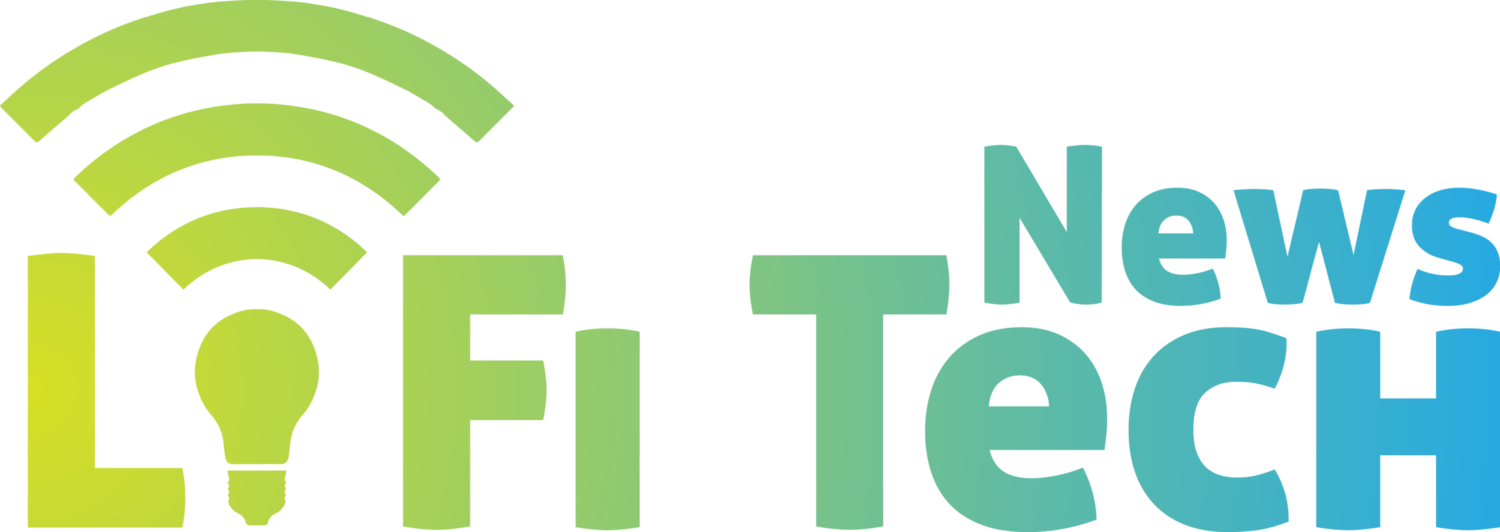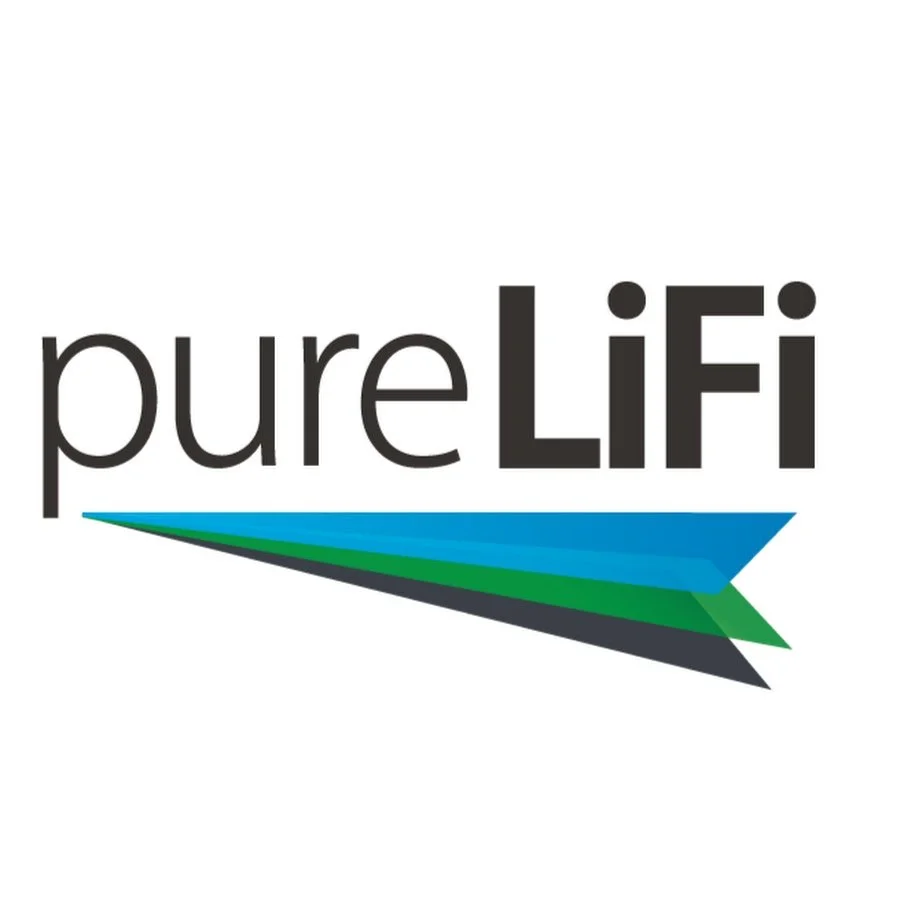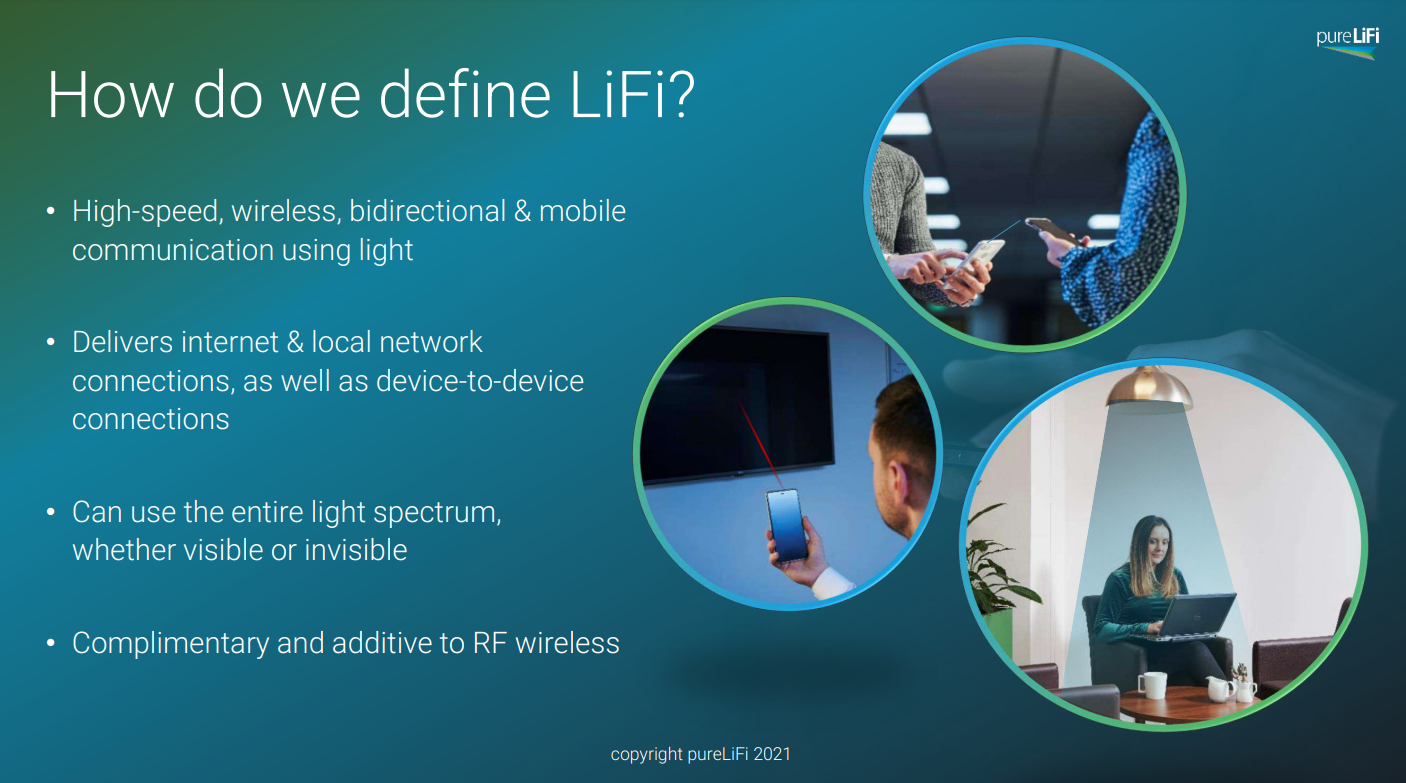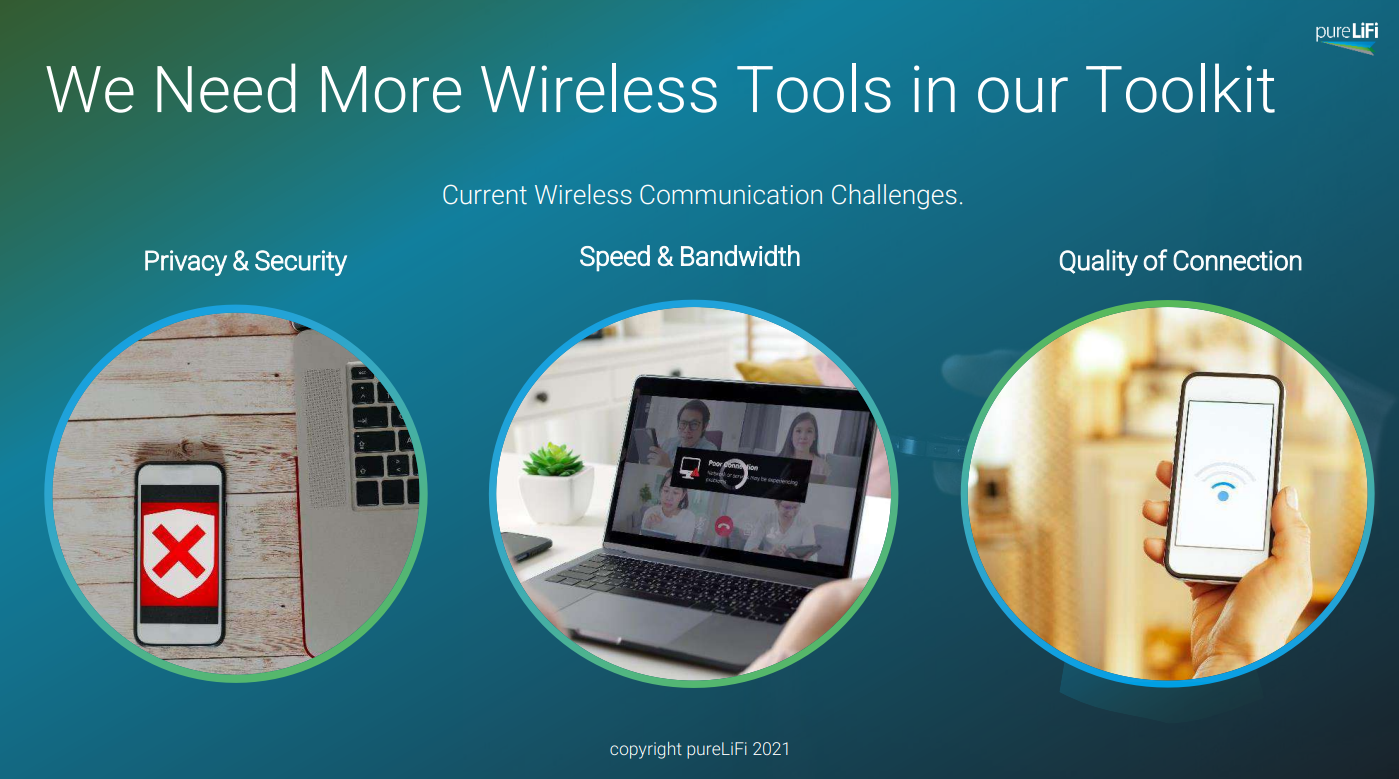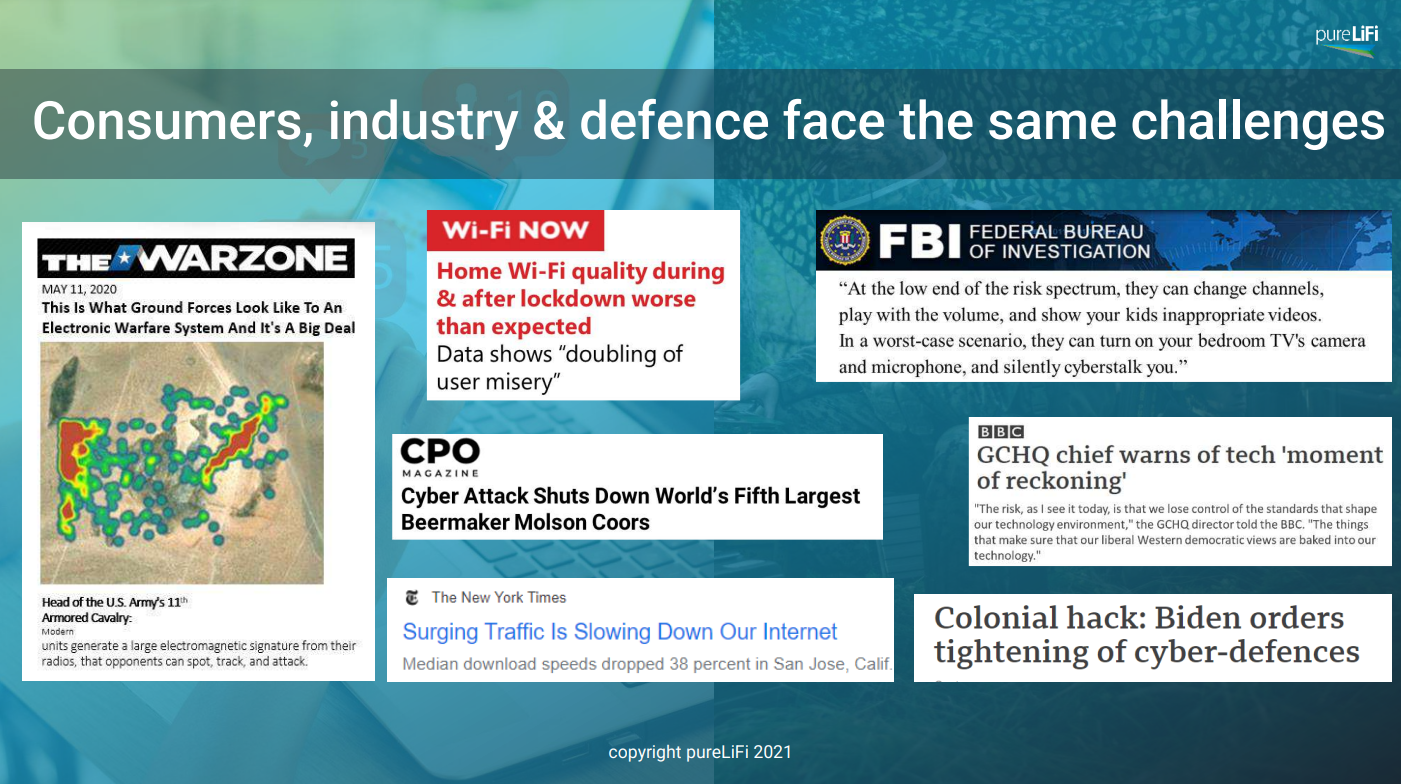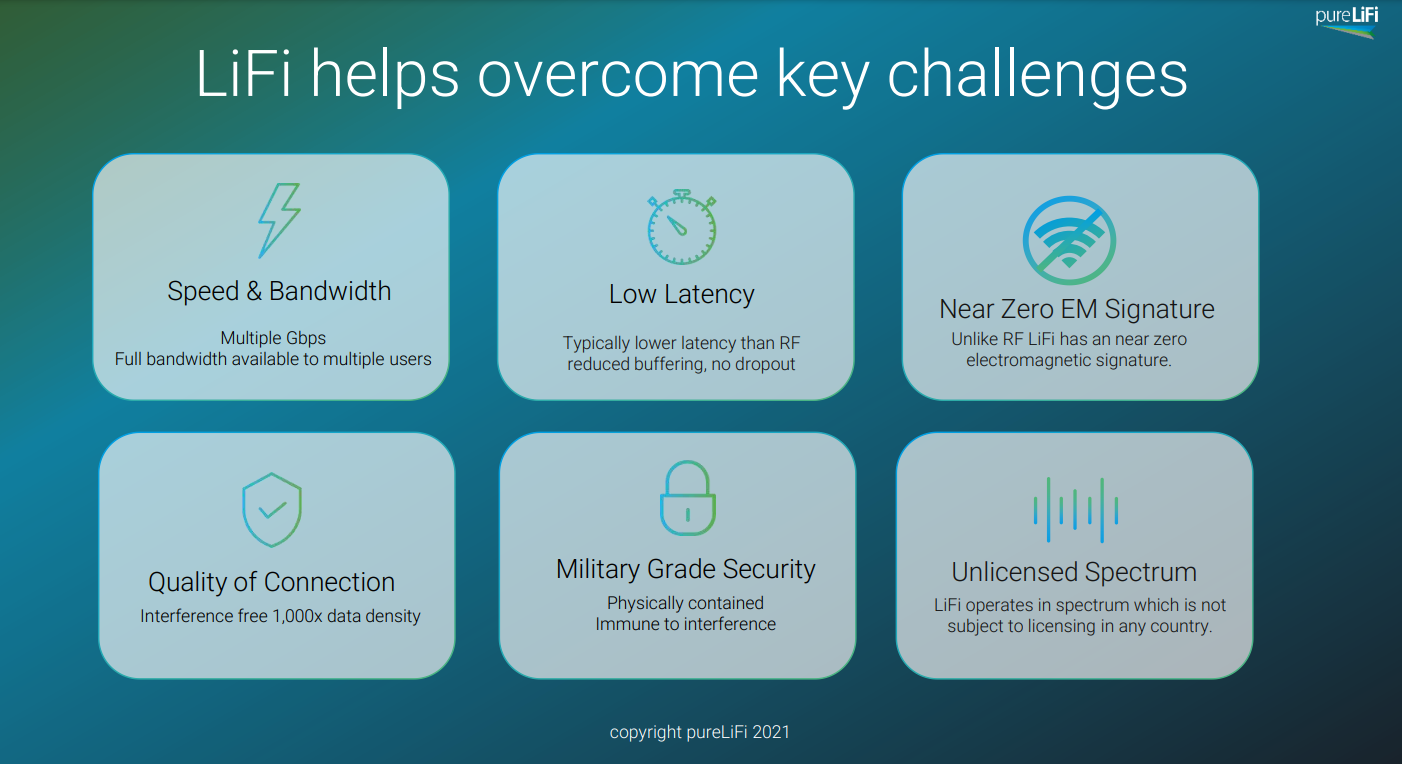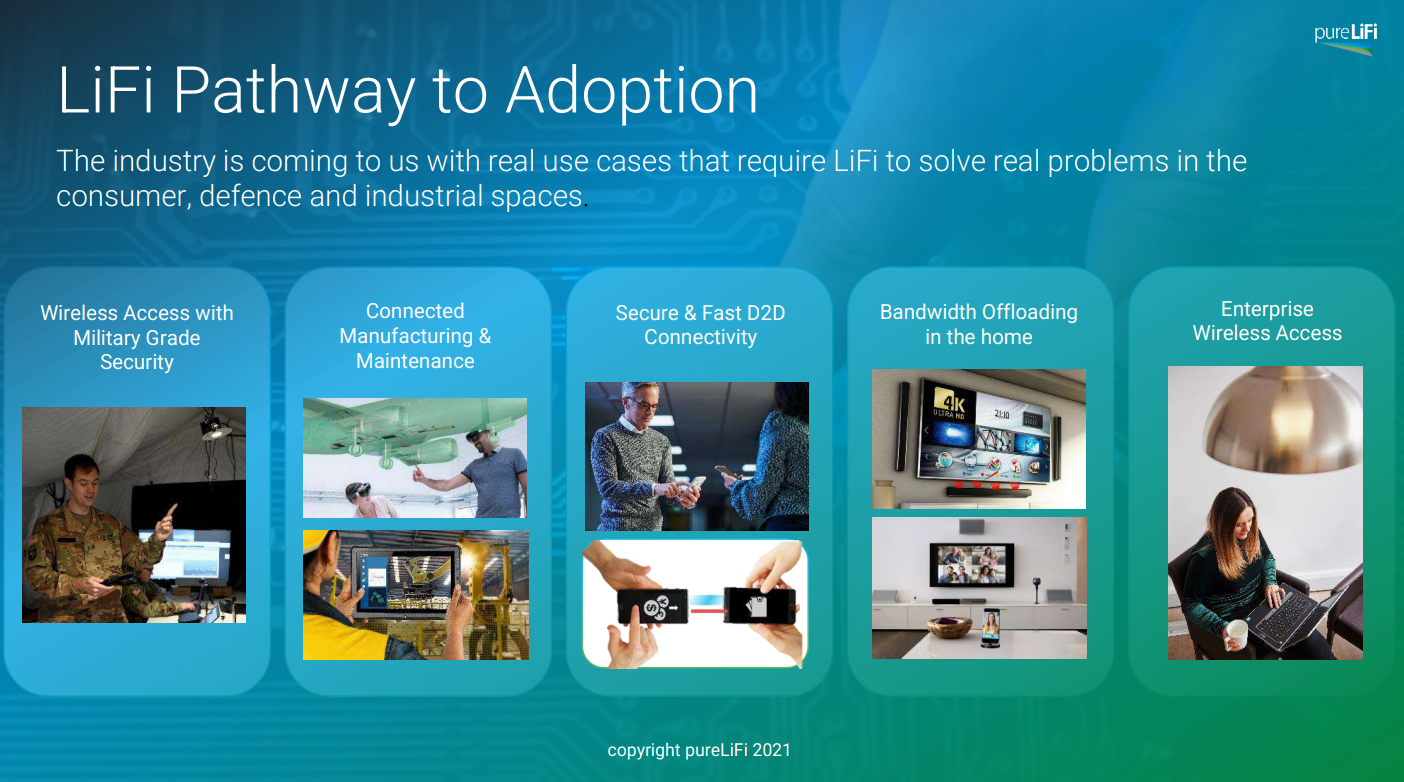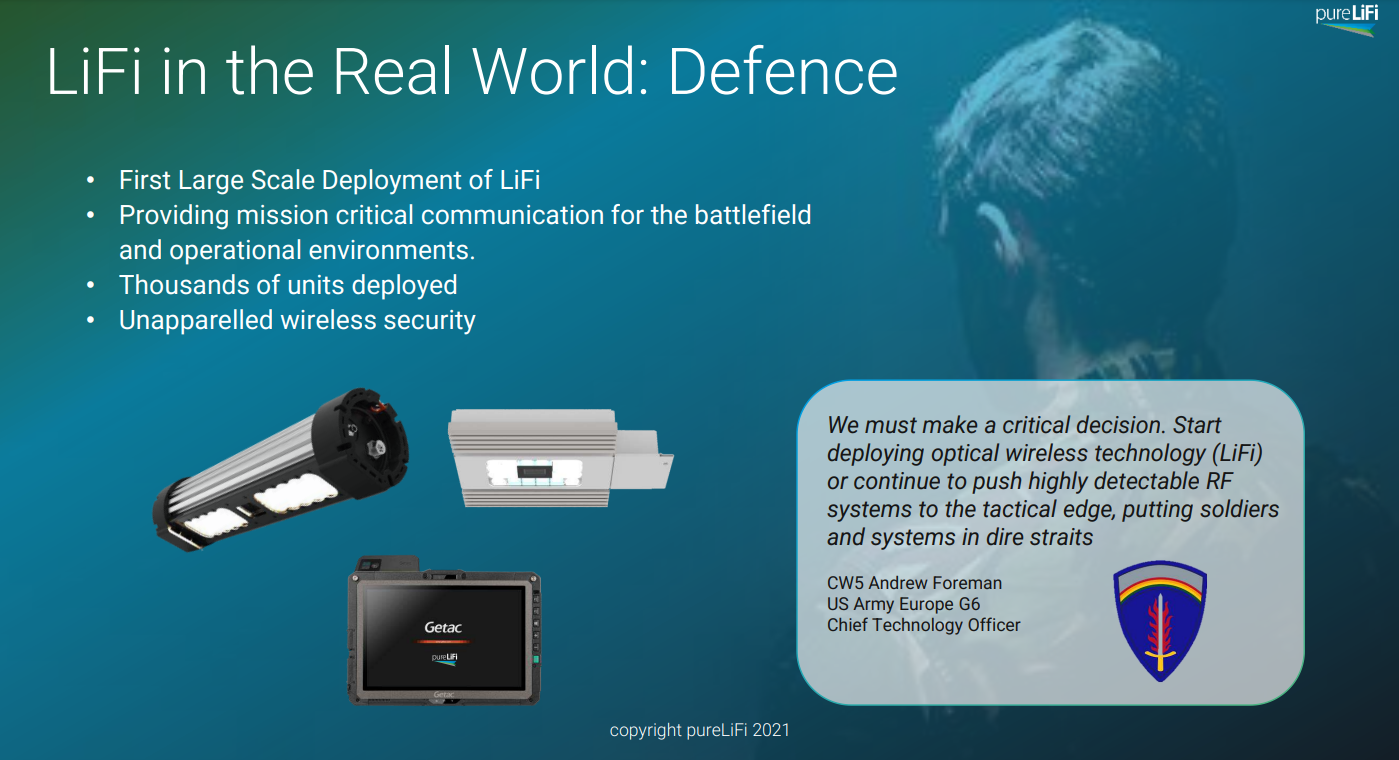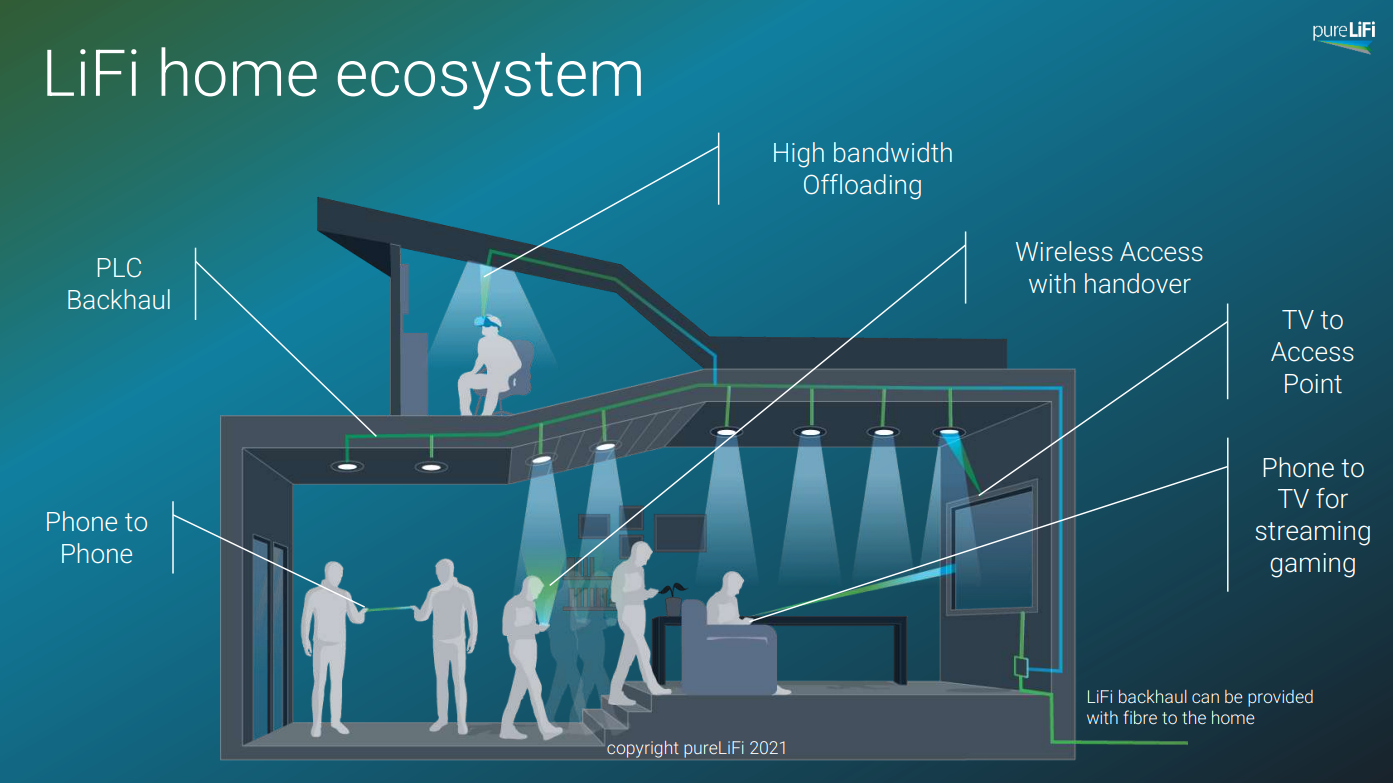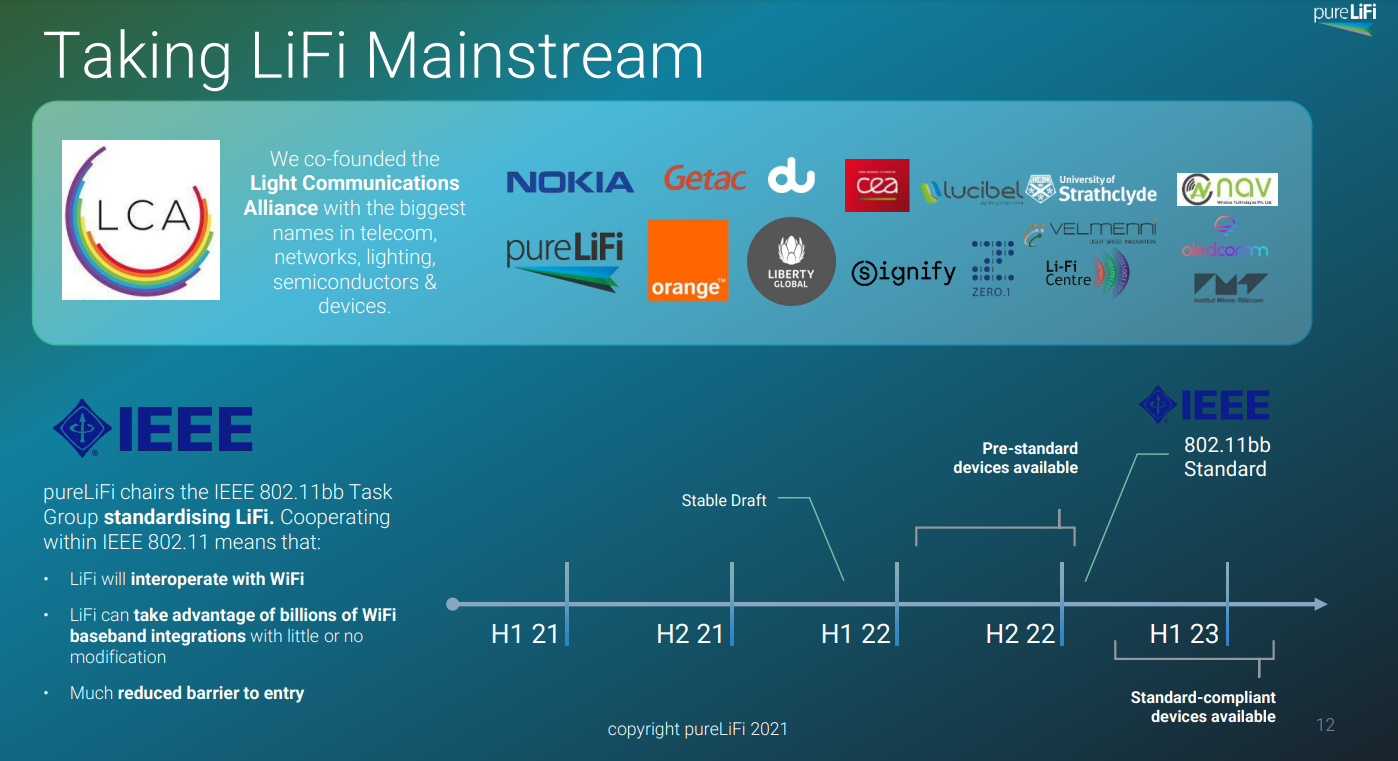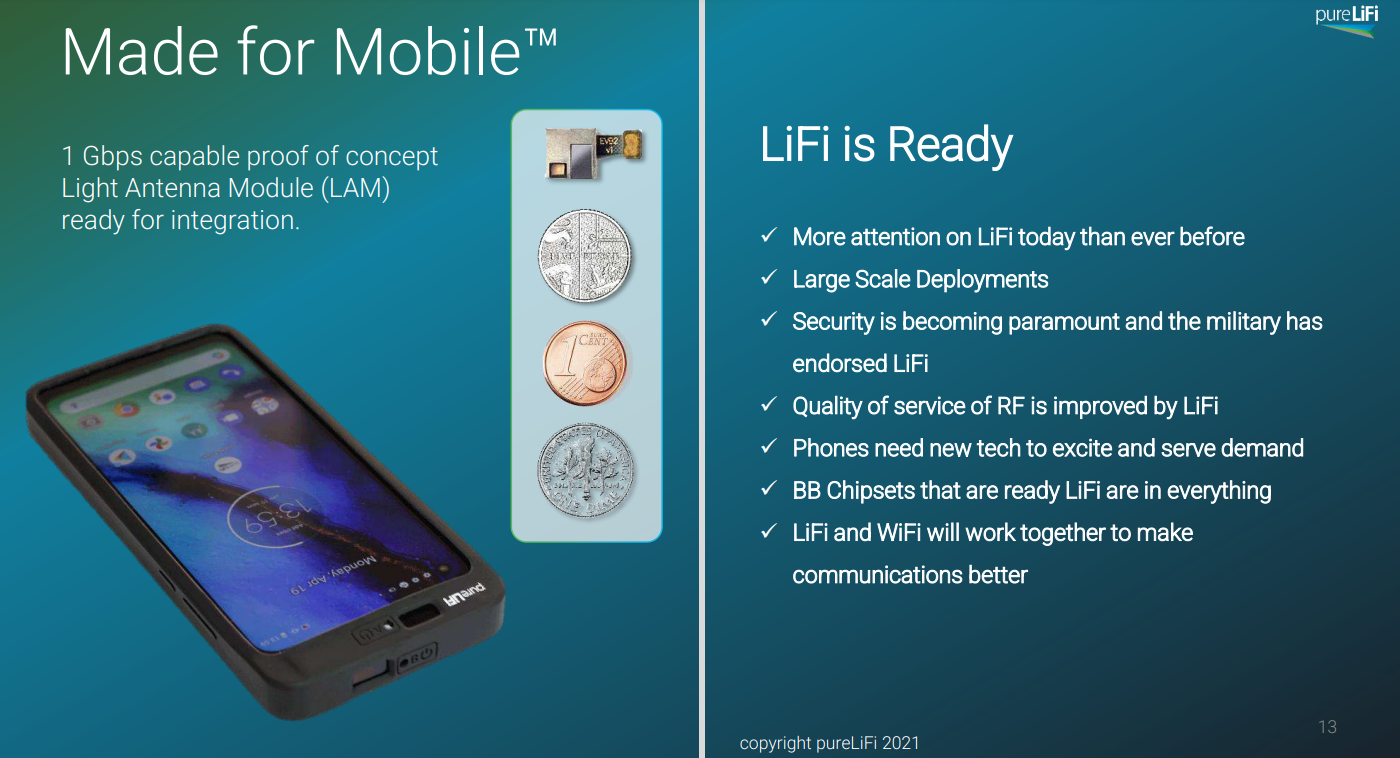Table of Contents
- Li-Fi Conference 2021
- pureLiFi
- Taking LiFi Mainstream by Nikola Serafimovski
- purelifi
- How do we define LiFi?
- We Need More Wireless Tools in our Toolkit
- Consumers, industry & defence face the same challenges
- LiFi helps overcome key challenges
- LiFi Pathway to Adoption
- LiFi in the Real World: Defence
- LiFi in the Real World: Education
- LiFi home ecosystem
- Taking LiFi Mainstream
- Made for Mobile™
- READY FOR THE MAINSTREAM
- Li-Fi Conference 2022
- What is LiFi?
- How does LiFi work?
- LiFi Benefits
- LiFi Applications
- Subscribe to LiFi Tech News
Li-Fi Conference 2021 - Recap Part 4 - Taking LiFi Mainstream
Li-Fi Conference 2021
In our last article from our ONLINE Li-Fi Conference 2021 recap series, we discussed the presentation delivered by Livia Rosu on “G.hn Backbone And Ecosystem Support For Li-Fi Use Cases, Standardization, Spectrum and Security”. The conference was organised by the Jakajima, the global High Tech Conference organiser, and the Light Communications Alliance.
Jakajima, Matchmaker for Innovators in the high tech industry, organises many events, ranging from LiFi Technology industry trends, 3D Printing to the Internet of Things, from Unmanned Cargo Aircraft to Health Tech, from 4D Printing to Photonics and from Vertical Farming to Sustainable Materials.
The online Li-Fi Conference included live presentations from researchers, executives and industry specialists from pureLiFi, Nokia, Signify, Orange, Radiocommunications Agency Netherlands, Velmenni, OLEDCOMM, HomeGrid Forum and Weidmüller Deutschland.
In another article recap series, we will talk about the presentation on taking LiFi mainstream delivered by Nikola Serafimovski from pureLiFi. Before this, let’s talk briefly about pureLiFi.
pureLiFi
pureLiFi develops technology for communication networks that integrates data and lighting utility infrastructures. It offers a LiFi enabled device that converts the beam of lights into an electrical signal. The signal is then converted back into data. The company was founded in 2012 and is headquartered in Edinburgh.
pureLiFi demonstrated the next LiFi system for the home at Mobile World Congress (MWC) 2022 in Barcelona. pureLiFi stated that this is the world’s first LiFi ecosystem for the consumer market, named LiFi@Home™.
pureLiFi CEO, Alistair Banham stated the following:
“The door is open for LiFi to fill the gap. LiFi is the key to unlocking the next generation of connected experiences in an ecosystem where WiFi and 5G alone are not enough. What we’ve demonstrated here for the first time is how simple it is to bring LiFi into consumer environments. We’ve done all the hard work to make LiFi easy to integrate and simple to get started.”
The LiFi@Home™ family of LiFi connected experiences is made of a consumer-style downlighter, a smartphone, a smart TV and an AR Headset all connected by LiFi. The LiFi@Home system is powered by an easy to install power line communication (PLC) network backhaul that uses existing electrical cabling to connect everything to the internet. Installing the LiFi@Home™ system is as simple as changing a downlighter.
Adding LiFi technology to a home will not only accommodate the growing demand for connected devices, it will also improve the user experience. LiFi enables more reliable connectivity that significantly improves latency and jitter and does not divide bandwidth. Next-generation experiences such as the metaverse and 8K streaming will be possible for everyone, pureLiFi claimed.
pureLiFi’s demonstration of consumer-ready LiFi products is enabled by their world-leading light antennas which are compatible with the same WiFi basebands that already exist in billions of connected devices today, allowing for easy integration of LiFi technology.
At MWC in Barcelona, pureLiFi CEO Alistair Banham made a direct call to the industry to show leadership beyond using WiFi and 5G. “LiFi is for leaders who want to differentiate and offer their customers the best experience. We are calling on the industry to look beyond ordinary and unleash innovation with LiFi. The next and best in connectivity solutions is ready for the taking. LiFi is ready for you to design into your products and put you at the forefront of the next big wave of technology innovation.”
Taking LiFi Mainstream by Nikola Serafimovski
Nikola Serafimovski, Co-Chairman at Light Communications Alliance and senior member from pureLiFi, was the fourth presenter at the online Li-Fi Conference 2021. He discussed in his presentation about Taking LiFi mainstream.
Nikola worked with major companies in the area of LiFi technology and commercialisation, leading the creation and cultivation of the LiFi ecosystem, marketing, sales and standardization. His experience with T-Mobile and T-Home in Macedonia focused on mobile network deployment and analysis as well as database app development. Nikola worked for the UK-China Science Bridges project to successfully demonstrate the world’s first practical implementation of the Spatial Modulation MIMO concept. He received a BSc in electrical engineering and computer science and an MSc in communications, systems and electronics, both from Jacobs University Bremen, Germany. Nikola earned his PhD in digital communications and signal processing from the University of Edinburgh.
Below are some points discussed about the Taking LiFi mainstream:
purelifi
Nikola Serafimovski started his presentation by saying the following:
“Thank you very much everybody for your time. We've had a lot of conversations about what is LIFI? And what are some of the ecosystems and the challenge that we have. So, this is really more looking at it from a pureLiFi’s perspective. So, a little bit about us. We were co-founded by Professor Howard Haas, who coined the term LIFI back in 2011. During the TED Talk, we've come out with the world's first with respect to LIFI systems that are generating revenue today, working with some of the largest technology providers and device vendors created the world's first light antenna, and a gigabit light on thin out with a strong patent portfolio and lots of awards and technology recognition products around the globe. We are relatively small, but very tightly knit team, based out of Edinburgh, and we're very, very excited to see change as a consequence of our work.”
How do we define LiFi?
“So, what do we mean when we talk about LIFI? This has been defined a number of times, and I guess an important element to add is we use the entire light spectrum visible or invisible or infrared, to deliver this interconnected network experience, but as well as looking at the opportunity of using the devices to connectivity, which is completely complimentary and additive, to what to RF solutions that exist in the market today.”
We Need More Wireless Tools in our Toolkit
“So, what do we need more wireless for? Right? That's basically what it comes down to? Well, I guess some of the challenges that we're facing today, as we mentioned previously, are privacy and security, security. There are a number of different attack vectors that effectively RF is vulnerable to. There are speed and bandwidth issues, in particular when it comes time for sharing the wireless medium. And especially if you're looking at the quality of service types of elements. And the quality of the connection is very, very important so that we're clear where and how that is going to look out for. So, we've identified kind of pain points that LIFI seems to be solving across a range of industries that boil down to some of these core features of LIFI.”, said Nikola Serafimovski.
Consumers, industry & defence face the same challenges
“So, if we look a little bit closer, what we see is that the defence industry, the industrial space, and the consumers have a similar range of problems. So, of course, some of the work that we've done with the US DOD is looking at the electromagnetic footprint and how those devices look like in the space. But what we're seeing is that Wi-Fi is suffering and cyber is suffering. In particular, when it comes down to the home environment and to the industrial enterprise IoT environment. We see there's a much greater threat coming into not just the enterprise space, but also the home space. And so, you have this transition where problems that used to be government only are very quickly becoming problems of the industry. I think probably the cyber attack shut down in the world's fifth-largest beer maker, Molson Coors was an issue. I think some of you probably saw the ransomware that there was a target for the NHS, and so on. So the question is, how do you try and come up with some of the solutions to some of the vulnerabilities with RF and how to improve that information assurance.”
LiFi helps overcome key challenges
“In our world, we think LIFI helps. So, LIFI can deliver the speed and bandwidth that's required. The low latency, which is, which can be easily much, much lower than their typical RF counterparts, because nobody's fighting for Channel access. It has a near-zero yen footprint, which means you can deploy it in almost any environment. And I'm sure people will be talking about some of the environments where they are using it, the quality of the connection can be much greater because the interference-free communications is there, in terms of the density of the network. So, you can keep adding LIFI access points. And you can keep reusing the full spectrum of the channel. You have very high levels of security, that physically limit your RF signals so that you know exactly where that information is going to and exactly who is listening to that information. And of course, because we're operating in an unlicensed spectrum or a licenced exempt spectrum, the same solution that is developed in China can be applied in Germany, or in Bolivia or in the US with no questions asked. It is simply identical. And that's very, very important when it comes time for understanding the overall consequences of spectrum sharing and licencing in particular on cross borders.”
LiFi Pathway to Adoption
“So, what's the pathway that we see? This is all about talking or trying to understand how does LIFI go mass market some of the ecosystem challenges were very well articulated by Musa, and they're, they're very real. We've tried to look at it from an end customer use case perspective and where we think the time is going to come through with us. So from what we've seen, and what we've experienced currently, wireless access with military-grade security is hugely important in defence space. And we've seen a significant uptake in that space as a core driver. That demand is now driving manufacturers and device integrators to create platforms, which is extending the toolkit that's available to the industry as a whole, connected manufacturing and maintenance are following on the back of that, as they're looking to create more digital environments in RF limited or denied spaces or insecure areas. And they're looking to integrate the next generation of productivity such as AR and VR capabilities, we see an uptick in the requirement for secure reliable, robust wireless communications in those spaces. Dovetailing along with the same feature sets and product requirements coming out of the Defence space. So both of those elements are here today and are moving forward. But we're also seeing, however, is the need for fast and secure device to device connectivity becoming more and more prevalent. And we'll zoom in on that feature, in particular, some of the kind of phone to phone connectivity that we've seen or phone to TV connectivity that we've seen. And lastly, we see that bandwidth offloading into the home will be critical. Why should you be hanging on your precious Wi-Fi system at home if you're trying to stream or cast your screen or marry a screen to the TV, when somebody is trying to download something with the phone in their pocket when you could be using light. And then, of course, that drives to the inevitable broader ecosystem of enabling every device in the home to be LIFI connected in the enterprise as well as the home space”.
LiFi in the Real World: Defence
“So, this was mentioned earlier, basically, looking at a specific case study. With the Kitefen product, we've deployed with the US Army, Europe and Africa. It's the first large scale deployment of LIFI of this nature, providing mission-critical communications, with 1000s of units, creating significant wireless security in the space. This is really looking at adding a meaningful element to an actual operational command, not just a proof of concept or a pilot. And this type of requirements and demand is what will drive this technology forward”.
LiFi in the Real World: Education
“But that's not the extent of it. We've also seen that transition into a complementary solution where deployment with the Kyle Academy in Scotland created actually a combined benefit. We deployed LIFI in a single classroom while the other classroom was still Wi-Fi enabled. And what we saw was an aggregate improved performance because the load was taking from the congested RF spectrum into the light spectrum. And it created a better learning and a better more connected environment for everybody in the space. And we see demand for these types of hybrid solutions increasing as people want to seamlessly transition without any thought between an RF in space and a light connected space”.
LiFi home ecosystem
“So, this is where we see the home coming in. You know, powerline communications was very appropriately discussed just now it is a great solution that can take from. It is a great solution that will take whatever fibre or coaxial cable ends up coming into the home from that box and distributed to every single socket that you have available for illumination in the space throughout the house. Instantly, you can get LIFI enabled PLC connected devices that are actually providing a full-blown home coverage use case. But in addition to that, you can have phone to phone communications or phone to TV communications or TV to access point communications. All of these bandwidth-heavy elements can now be connected with LIFI in the home”.
Taking LiFi Mainstream
“So, what have we seen? Well, we've seen way back when starting with prototype LIFI systems, to commercial systems to initial pilots and industry offices and defence to smartphones and proof of concepts being and a tablet proof of concept is being developed. And that's kind of where we are now. We see that movement of the real world defence and industrial applications really taking into the next stage for real-world office and retail deployments. And some of the speakers later will talk to their experiences with deploying LIFI into offices, in the automotive and industrial spaces. This is the pathway that will lead to consumer-grade pilots and when eventually standardisation is done, of course with the IEEE 802.11bb being very important for this stage, we also see mainstream LIFI coming through. And the 802.11bb standard in particular brings in that kind of consumer-grade, chipset availability for Wi-Fi that is found in almost every single device in the world today. And that's what will allow the scale and the transition from specialist use cases into very much mass-market use cases”.
“The Light Communications Alliance, as was discussed earlier, plays a huge role in how this shapes up and we would really, really welcome and encourage everybody to join us on this journey and help us create this ecosystem and make sure that we're addressing the problems that you see. At the same time, though I chair the IEEE 802.11bb Task Group, which is standardising lifeline to scope which means LIFI according to 802.11bb will be natively interoperable with Wi-Fi, there are billions of Wi-Fi baseband chipsets that are available and integration with them can be done with very minimal if any modification to the chip to the chipset. It is a much-reduced barrier to entry for the mass market. at a very high level, this is the kind of standardisation timeline, we're looking at getting a stable draft sometime in the first half of next year, potentially pre-standard devices available in the second half of next year and really standard-compliant devices available sometime in 2023. This is a very high-level graphic, it is not meant to commit the tgbb group to any such timings. And it's very very important to understand that this 802.11bb group is a standards body that is contributions driven. So, while we try to do our best to get it on time and make sure that things happen. At the end of the day, the members decide the pace of change in that environment. But what we're really seeing is that the LCA in combination with tgbb. And the mass market is what creates that kind of fertile ground for mass-market deployability”.
Made for Mobile™
”So to that extent, pureLiFi has created a made for a mobile system, which has a light antenna that is roughly the size of a single euro cent designed specifically for mobile devices communications. LIFI really is ready, it's ready for today. And as Musa has said earlier, it gets more and more advanced on a daily basis. Large scale deployments are there as most of set the technology is sufficient for the use cases that are needed. Security is an important quality of service for phones with new technology that can really excite and serve demand baseband chips as that are ready for LIFI are in everything if you're especially if you take data to that 802.11bb approach. And with that approach, you can make LIFI work together seamlessly”.
READY FOR THE MAINSTREAM
The presentation was concluded with the following statements:
“There is no transfer of data allowing for the user to control where information is shared. This makes LIFI particularly useful for sending payments or secure information. It is also possible to screen share between phones taking advantage of LIFI fast low latency connections. LIFI can enable all-new multiplayer gaming scenarios that enable fast, reliable, low latency gaming just like using your console at home. As you can see here, the use of LIFI is not only fast but provides intentional and secure connections. As LIFI does not use radio frequencies and offers low latency connections, the user experience and the quality of connections can enable new user experiences with just your mobile phone”.
You can also watch the full video presentation on the following YouTube link from Jakajima YouTube channel.
Li-Fi Conference 2022
The next Li-Fi Conference is coming up on the 28th of June 2022 between 10 am and 4.30 pm CET.
It is interesting to realise that lights that illuminate offices, homes, cars, factories, our streets and more locations also can connect us to data and hence power the growing demand for connectivity and speed.
At this conference professionals from all over the globe will gather together in order to share applications, ideas, new developments and ways to integrate Li-Fi in services, both for consumers and professionals.
This conference will be held Live and Online. The venue will be the High Tech Campus 1, The Strip 5656 AE Eindhoven The Netherlands.
Online tickets can be bought at the following link:
https://tikcit.com/register/61e002336d7fc4b6745cab83/
What is LiFi?
LiFi, also known as "Light Fidelity" is a wireless optical networking technology, which uses light-emitting diodes (LEDs) to transmit data. In 2011, professor Harald Haas made a LiFi demonstration at the TED (Technology, Entertainment, Design) Global Talk on Visible Light Communication (VLC).
VLC uses light as a medium to deliver high-speed communication like Wi-Fi and complies with the IEEE standard IEEE 802.15.7. The IEEE 802.15.7 is a high-speed, bidirectional, and fully networked wireless communication technology-based standard similar to Wi-Fi's IEEE 802.11.
How does LiFi work?
LiFi is a high speed, bidirectional, and fully networked wireless communication of data using light. LiFi constitutes of several light bulbs that form a wireless network.
When an electrical current goes through to a LED light bulb, a stream of light (photons) emits from the lamp. LED bulbs are semiconductor devices, which means that the brightness of the light flowing through them can change at extremely high speeds. The signal is sent by modulating the light at different rates. The signal can then be received by a detector that interprets the changes in light intensity (the signal) as data. Also when the LED is ON, you transmit a digital 1, and when it is OFF, you transmit a 0.
LiFi Benefits
The primary benefits of LiFi are as follows:
• Security: Provides entirely secure access. Where there is no light there is no data.
• Safety: Does not produce electromagnetic radiation and does not interfere with existing electronic systems.
• Localisation: Allows localisation due to the small coverage area of LiFi access point - localisation can be used for very precise asset tracking.
• Data density: Provides ubiquitous high-speed wireless access that offers substantially greater data density (data rate per unit area) than RF through high bandwidth reuse.
Credit to Oledcomm
LiFi Applications
LiFi can be used for so many applications and the list is increasing every year. You can read our updated list of Li-Fi applications at the following link:
Credit to pureLiFi
In conclusion, if you are also interested to hear more information about the OWNII Coin or enquire about LiFi devices such as the LiFiMax and Trulifi, you can contact us through our chatbot or by sending an email through our contact us form. If you enjoyed this post and would like to hear more updates about LiFi technology, subscribe to our newsletter. Don’t forget to subscribe to our social media accounts. You can also join our Telegram group about LiFi technology on this link:
https://t.me/joinchat/FMzOmsEKyJFrU6Af
